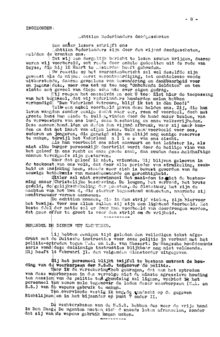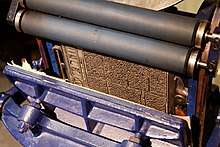Het Parool
Het Parool (Dutch pronunciation: [ˈɦɛt paːˈroːl]) is an Amsterdam-based daily newspaper. It was first published on 10 February 1941 as a resistance paper during the German occupation of the Netherlands (1940–1945).[1] In English, its name means The Password or The Motto.
 Page from the edition of 9 April 1941 | |
| Type | Daily newspaper |
|---|---|
| Format | Tabloid |
| Owner(s) |
|
| Publisher | DPG Media |
| Editor-in-chief | Ronald Ockhuysen |
| Associate editor | Kamilla Leupen |
| Staff writers | 73 |
| Founded | 1940 |
| Language | Dutch |
| Headquarters | Jacob Bontiusplaats 9, Amsterdam, Netherlands |
| Circulation | 64,000 subscription; 20,000 street sales |
| Sister newspapers | Algemeen Dagblad |
| ISSN | 1389-2975 |
| Website | www |
Second World War
The paper was preceded by a stenciled newsletter which was started in May 1940 by Frans Goedhart.[1] In late 1940, Wim van Norden joined the group of producers of the newsletter; Van Norden would later serve as director of the newspaper between 1945 and 1979.[2] Jaap Nunes Vaz also became involved with the newspaper. In 1944, the paper, albeit illegal and vigorously persecuted, reached a circulation of approximately 100,000, and it was distributed by the Dutch resistance.[1] Other important contributors were Simon Carmiggelt and Max Nord, who lived with Van Norden and their families on the Reguliersgracht, in the headquarters of the paper, which was never discovered by the Nazis.[3]
Numerous staff were apprehended and killed by the Germans and their Dutch collaborators. Alphons Meeuwis who distributed the paper was arrested in 1941 and sent to various camps. Nunes Vaz was arrested by the Gestapo on 25 October 1942 and sent to Sobibor concentration camp.[4]
Postwar

After the war, Het Parool quickly became one of the largest newspapers in the Netherlands, partly because much of the population appreciated it for being the most prolific resistance paper and partly because newspapers that had collaborated with the German occupier were banned from publication.[5]
Apart from its main publication, Het Parool published magazines and local newspapers in the Netherlands. A string of locally-based newspapers appeared alongside Het Parool, including Het Rotterdamsch Parool (1947–1971), Nieuw Utrechtsch Dagblad, Haagsch Dagblad,[6] and Het Flevoparool (1982–1988). These local publications were all discontinued in the late sixties, early seventies, or (in the case of Het Flevoparool) eighties.
Readership reached its peak in the mid-1960s with a subscription of over 400,000, making it the second-biggest newspaper in the Netherlands at that time. In the latter part of the 1960s, the newspaper, under conservative editor in chief Herman Sandberg, vehemently supported the Vietnam War, which alienated a substantial part of Het Parool's majority liberal and left-wing readership.[7] This started a steady decline in subscriptions and circulation, which persisted for almost four decades.
Perscombinatie and PCM
In 1968 Het Parool started the publishing company Perscombinatie (English: Press Combination) with competitor De Volkskrant, mainly to join investment in new printing presses. In 1973 Trouw, also a former resistance paper, joined the corporation.[8]
At the start of Perscombinatie, Het Parool was the leading paper, but due to its declining circulation, De Volkskrant took over the prime role within the company starting in the early eighties, although the owner of the Het Parool, Stichting Het Parool (English: The Parool Foundation) remained the majority shareholder, with 57 percent of the shares of Perscombinatie. After Stichting Het Parool merged with book publisher Meulenhoff, the two formed Perscombinatie and Meulenhoff & Company (PCM). By 1992, PCM was the biggest publisher in the Netherlands; in 1995, PCM took over fellow Nederlandse Dagbladunie, publisher of daily newspapers NRC Handelsblad and Algemeen Dagblad.
Termination and restart
In the 1990s, Het Parool started turning a loss, due to stiff competition and a lack of investment by PCM. The paper tried several different programs to counter this (including a move toward being a local Amsterdam newspaper in 1997), but these showed few results.[9] In 2002, PCM announced termination of the paper, citing substantial losses and declining readership.[10]
But instead, majority shareholder Stichting Het Parool opted for a management bailout of the newspaper, in effect terminating its ownership of PCM in return for the rights to publish Het Parool. The bailout took effect on 1 January 2003. PCM was subsequently acquired by British-based investment group Apax Partners, which led to substantial debts and significant problems for the company.
To strengthen this new ownership base, De Persgroep, the biggest newspaper publisher in Belgium, was asked to take a substantial minority share in the setup,[11] alongside minority participation by both staff and readers. As a stand-alone newspaper, Het Parool remained national, yet with a focus on its Amsterdam home base.
In the new configuration, and after a collective layoff of 43 staff, Het Parool returned to profit within a year. On 30 March 2003. Het Parool became the first newspaper in the Netherlands to switch from broadsheet to tabloid format, a move which since has been followed by all other major and local newspapers in the country. In a declining market, Het Parool was one of the few daily newspapers in the Netherlands able to expand its readership every year until 2011. It has turned a profit every year since its bailout.
For Belgium-based De Persgroep, Het Parool served as a foothold in the Netherlands, leading to the acquisition of a majority of the struggling PCM in 2009.[12] In 2011, Het Parool was re-absorbed by PCM, which was renamed Persgroep Nederland. Former Stichting Het Parool management began to run the company, closely re-establishing the Perscombinatie-situation of the 1970s.
Between 2001 and 2011, Het Parool operated its own theatre as a forum for debate and culture.
In February 2012, Het Parool acquired Amsterdam-based commercial television station AT5[13] with public broadcaster AVRO and regional TV station RTV Noord-Holland to form a new multimedia corporation, which will also include online activities of both Parool and AT5, within De Persgroep.
Organization and subscription

As of 2015 Het Parool has a staff of 73, who are based at the City desk, Arts and Media, Sports, Foreign, and Business desks. The paper consists of a news section and a daily, themed magazine called PS. On weekends, a glossy, PS van de Week, is published alongside the newspaper. The current editor in chief is Ronald Ockhuysen. Het Parool is affiliated with Algemeen Dagblad—the papers share a Politics desk—Trouw, and regional newspaper Dagblad van Het Noorden.
Its daily circulation, through subscription, is 64,403 copies.[14] Street sales circulate approximately 20,000 and substantially more on weekends. Het Parool has the largest circulation in the Amsterdam conurbation. The editorial office is based in the city centre of Amsterdam, with an annex in The Hague.
Layout and typeface
Het Parool was restyled twice by Mario Garcia: in 2004 (when it became a tabloid),[15][16] and in 2008. Het Parool was voted best designed newspaper by the European Newspaper Award twice, in 2004 and again in 2016, after another redesign by Jacek Utko commemorating the paper's 75th birthday.
Until 2008 the newspaper used the typeface Swift from Gerard Unger. In 2008 the newspaper was restyled and uses the Meta Serif from Erik Spiekermann and the Strada from Pinggera for the headings.
See also
References
- "Stichting Democratie & Media - Geschiedenis". stdem.org. Retrieved 19 January 2015.
- Hanneloes Pen (29 May 2015). "Parool-oprichter Wim van Norden (97) overleden". Het Parool (in Dutch). Retrieved 8 June 2015.
- Gelder, Henk van. "Max Nord (1916-2008)". NRC Handelsblad (in Dutch). Archived from the original on 8 July 2015. Retrieved 7 July 2015.
- "Digitaal Monument Joodse Gemeenschap in Nederland" (in Dutch). Retrieved 19 December 2009.
- Madelon de Keizer: Het Parool 1940-1945. Verzetsblad in oorlogstijd. Proefschrift Universiteit Leiden, 1991. 2e herz. druk: Amsterdam, Cramwinckel, 1991. ISBN 90-71894-28-2 en ISBN 90-71894-27-4
- "Archives". IISH. Retrieved 19 January 2015.
- Herman Sandberg (1918-2008) Archived 28 April 2014 at the Wayback Machine NRC. Retrieved 19 January 2015.
- History Archived 9 June 2012 at the Wayback Machine Perscombinatie.
- Paul Koedijk en Gerard Mulder, Léés die Krant! Geschiedenis van het na-oorlogse Parool 1945-1970, Amsterdam, 1996.
- "Smaling gelooft niet in doorstart Parool". Villa Media. Retrieved 19 January 2015.
- History Archived 30 May 2012 at Archive.today De Persgroep.
- "Persgroep neemt belang in PCM Uitgevers". Villa Media. Retrieved 19 January 2015.
- "Overname AT5 ook financieel rond". Villa Media. Retrieved 19 January 2015.
- Hoi Harde Cijfers Archived 1 November 2013 at the Wayback Machine Hoi Online.
- "The Results of the Sixth European Newspaper Award". Editorial Design. Archived from the original (Press release) on 23 September 2015. Retrieved 19 January 2015.
- Mario R. Garcia (June 2004). "Rethink, not redesign" (PDF). Strategy Report. 3 (3). Retrieved 6 February 2015.